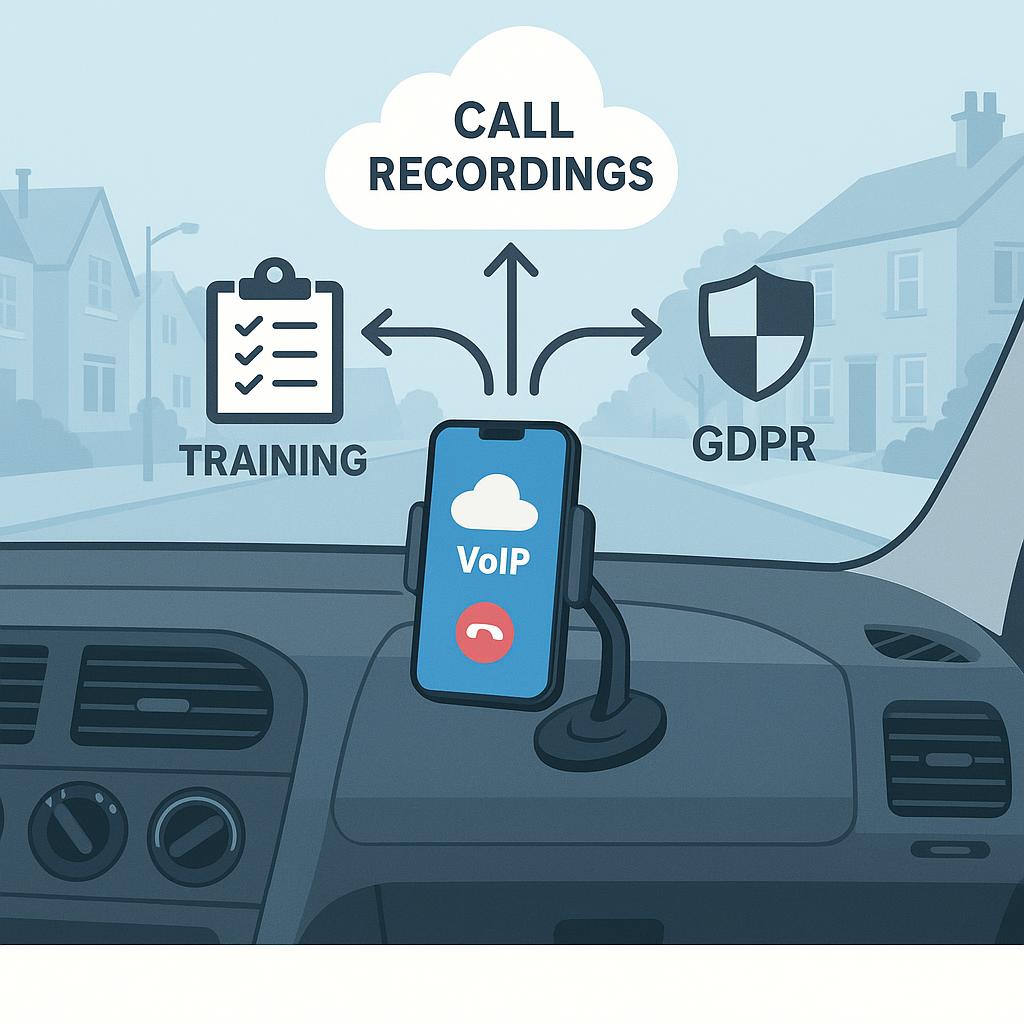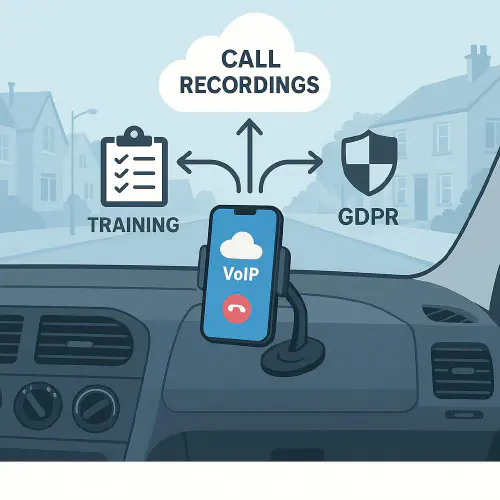
Record business calls legally: simple setup on 3CX, RingCentral and Vonage
Category: Tools, Materials & Tech • Niche: VoIP, call recording, GDPR, Ofcom, small trade teams

Simple VoIP call recording setup for a UK trade business
Contents
- Who this is for
- Quick answer
- Legal basics in plain English
- 15-minute setup: 3CX
- 15-minute setup: RingCentral
- Alternative: Vonage checklist
- Retention, security and access control
- No-signal and mobile calls: what actually works
- Outbound calls: avoid silent call issues and show your number
- Troubleshooting and audit pack
- FAQ
Who this is for
- Owner-operators and small teams who want to record customer calls for training, quality or dispute resolution.
- Teams moving from PSTN to VoIP and need a compliant, practical setup.
- Office managers who want a clear policy, scripts and retention rules that stand up if challenged.
Helpful related reads:
- PSTN switch off survival plan for trades: move to VoIP in 10 simple steps
- Voicemail to job: auto-transcribe missed calls and create jobs
- Auto text back for missed calls
Quick answer
- You can record business calls in the UK without asking for consent each time if you choose a valid lawful basis and tell people clearly. For routine service or training, most small firms use legitimate interests with a short announcement and a clear privacy notice.
- Do not use call recordings for marketing unless you meet PECR rules. For any automated marketing calls you generally need prior consent.
- Keep recordings only as long as needed, secure them, and know how to find and export a copy if a customer asks.
Legal basics in plain English
- Choose a lawful basis before recording. For service quality or training, legitimate interests is commonly used if people would reasonably expect it and you minimise the impact. Do a short Legitimate Interests Assessment and file it. See the ICO’s guide to legitimate interests.
- Be transparent. Tell callers at or before the start that calls may be recorded, why, and where to read your full privacy info. See ICO on the right to be informed.
- If you rely on consent, it must be freely given, specific and easy to withdraw. See ICO on consent management.
- Marketing calls are different. Automated marketing calls need consent and live marketing calls have specific PECR rules. See ICO on telephone marketing.
- Recording employee calls counts as monitoring. Keep it necessary and proportionate, tell staff, and consider a DPIA. See ICO on monitoring workers.
Tip: If your work phones are now VoIP because of the PSTN switch off, double-check 999 access and provider resilience. Ofcom’s guidance on emergency-call access is here: Power cuts and access to emergency organisations.
15-minute setup: 3CX
This gets you basic, compliant recording on a self-hosted or hosted 3CX.
- Decide scope
- Record all inbound to the main number and on-demand for engineers’ extensions. Keep outbound sales non-recorded unless you have a clear basis.
- Announcement and privacy info
- Add an IVR or greeting: “We record some calls for training and quality. See our privacy notice at yoursite.co.uk/privacy.” Put the full privacy notice on your site.
- Enable and test recording
- In 3CX Management Console: Extensions → select extension → Options → Record Calls. Choose Always or On Demand. For queues: Call Queue → Recordings → Enable.
- Test inbound and outbound and verify files land in your recordings store.
- Storage and retention
- Set a retention rule, for example 90 days for routine calls and longer only for active disputes. Keep access limited to managers.
- Access control
- Create a shared folder with restricted access or use 3CX’s role controls so only approved users can play or download recordings.
- Document it
- Save a one-page SOP describing who is recorded, why, where files are stored, and how long you keep them.
15-minute setup: RingCentral
Solid cloud option with clean admin controls for UK teams.
- Set recording mode
- Admin Portal → Phone System → Auto-Receptionist → Call Recording. Enable Automatic Call Recording for selected users or departments. For sensitive roles keep to On-Demand.
- Add announcement and link to privacy
- Configure your IVR greeting with the short disclosure and point to your website privacy notice.
- Retention and access
- Set retention in Analytics or Recordings settings to match your policy. Restrict download rights to managers. Audit who can access recordings.
- Prove it works
- Make a test call and confirm the call shows in Recordings with the correct user and timestamp. Export one file and store a sample in your audit pack.
Helpful demo:
Alternative: Vonage checklist
Vonage Business Communications supports automatic and on-demand recording with admin policies.
- Turn on recording at the user or call queue level.
- Add a front-of-queue announcement that mentions recording and points to your privacy notice.
- Set a default retention, ensure recordings are stored in the approved region, and restrict access by role.
- Run a monthly spot-check that a random sample plays, has a timestamp, and can be exported for a subject access request.
Retention, security and access control
- Retention
- Routine service calls: 30 to 180 days is typical. Keep longer only for ongoing complaints or legal reasons. Document your schedule.
- Security
- Store recordings in provider storage or a secure cloud drive with MFA. Don’t email files around. Encrypt at rest if exporting.
- Access
- Least privilege. Only named roles can play or download. Keep an access log where possible.
- Subject access requests
- A customer can ask for a copy. Know how to search by date, number and agent, and how to redact third-party data if needed. See ICO guidance on accountability and record keeping in video-surveillance guidance.
No-signal and mobile calls: what actually works
- Native mobile calls on iPhone and many Androids cannot be auto-recorded for privacy and OS reasons. Use your provider’s VoIP app over data or Wi-Fi if you need recording.
- Rural jobs with poor data
- Use Wi-Fi calling or a multi-network SIM in the van router so your VoIP app stays online.
- If a call drops, your safety net is voicemail to ticket: capture voicemail, auto-transcribe and create a job. See our guide: Voicemail to job.
Outbound calls: avoid silent call issues and show your number
If you use diallers or click-to-call from your CRM:
- Present a valid, returnable UK number. Ofcom expects a diallable CLI and providers must block spoofed UK numbers from abroad. See Ofcom’s CLI guidance.
- Avoid silent calls. If a call is abandoned, play an information message promptly and include who called and a basic-rate opt-out number. See Ofcom’s Persistent Misuse policy and advice on abandoned and silent calls.
Troubleshooting and audit pack
Keep a simple folder called “Call Recording Audit” with:
- Your lawful basis note: one page LIA or the consent approach if you use it.
- Scripts: the exact announcement text and your privacy notice link.
- System screenshots: where recording is enabled, where retention is set, and who has access.
- Test evidence: one exported file per quarter with date, time, number, and agent noted.
- Issue log: any failures and fixes, e.g., an extension not recording after a change.
Sample announcement scr…